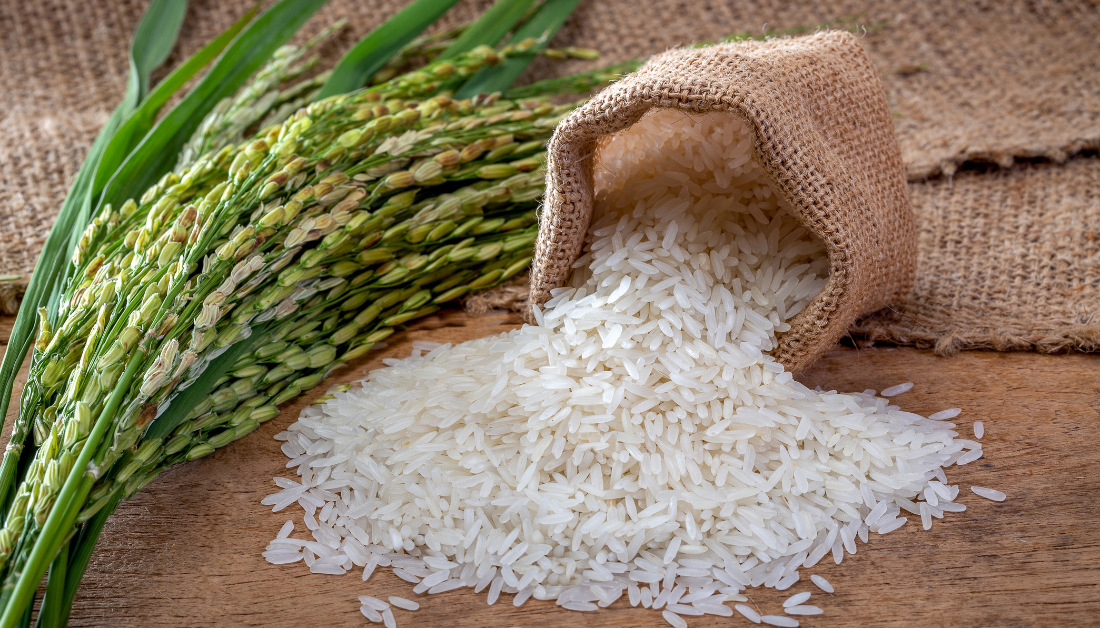

Scientists from the International Rice Research Institute (IRRI), a CGIAR Research Center, have found the genes responsible for low and ultra-low glycemic index (GI) in rice in an effort to help curb the rising instances of diabetes worldwide. This new finding will be able to turn popular rice varieties into low and ultra-low glycemic index for refined white rice using standard breeding procedures while maintaining good grain quality and yield.
The first batch of ultra-low GI rice samples created from the Samba Mahsuri x IR36ae cross was publicly delivered to Philippine President Ferdinand Marcos, Jr. at the 6th International Rice Congress opening ceremony.
“Thank you for conducting the 6th International Rice Congress which I am sure will promote the development and use of more quality rice varieties and technologies such as the ultra-low glycaemic index or ultra-low GI rice,” said Marcos.
He added, “The discoveries in this congress will pave the way for greater strides in the rice industry in the Philippines and across the globe.”
IRRI has already identified two low GI Philippine varieties, IRRI 147 and IRRI 125, which have already been released as salt-tolerant cultivars in the Philippines. IRRI 147 had a GI value of 55 based on clinical validation on human volunteers in a cohort study, while IRRI 125 had a GI value of 51.1.
Diabetes is spreading at an alarming rate all over the world. According to the International Diabetes Federation, there will be 537 million diabetics in 2021, with a 47% increase by 2047. Many cultivated rice types have GIs ranging from 70 to 92, which is not recommended for diabetics.
GI values below 45 are considered ultra-low, 46-55 are considered low GI, 56-69 are considered intermediate GI, and 70 and beyond are considered high GI. With transparent backgrounds, the newly discovered ultra-low GI line has a GI level of 44.
IRRI discovered highly significant marker-trait relationship markers for distinguishing intermediate from high GI in 2019. The breakthrough comes from IRRI, which has now established the genetics for low GI and ultra-low GI and developed pre-breeding lines with low GI and ultra-low GI distinctive traits in a high-yielding background.
“IRRI’s latest discovery offers the opportunity to develop rice varieties with low GI, and for the first time ever, ultra-low GI levels, to meet the health needs and dietary preferences of consumers,” said Dr. Nese Sreenivasulu, Head of IRRI’s Consumer-driven Grain Quality and Nutrition Research Unit and the lead of this discovery, adding that in collaboration with relevant institutions in different countries, these lines can also be used as donors to transfer low and ultra-low GI traits to popular rice varieties with different grain size and shape, as well as in different maturity backgrounds.
This scientific breakthrough is the result of a larger South-South collaboration between IRRI scientists at the IRRI global headquarters in the Philippines and the IRRI South Asia Regional Centre in Varanasi, India, which was inaugurated by India’s Prime Minister Narendra Modi with the goal of fostering research partnerships across regions.
“We are keen on supporting the continued research for this milestone discovery. We are already discussing ways on how PhilRice can use this breakthrough on low GI rice toward incorporating this in Philippine varieties,” Dr. Leo Sebastian, Undersecretary for Rice Industry Development of the Department of Agriculture, said.
“These research breakthroughs possess much-needed health benefits and tremendous market potential. We look to partnering with as many national systems as possible to help fast track the release of low and especially the ultra-low GI rice varieties,” said IRRI Interim Director General Dr. Ajay Kohli, adding that the ultra-low Glycemic Index variety will be market-ready within two years through a collaboration between IRRI and PhilRice.
For more information: International Rice Research Institute (IRRI)
more recommended stories
 Silica Nanomatrix Boosts Dendritic Cell Cancer Therapy
Silica Nanomatrix Boosts Dendritic Cell Cancer TherapyKey Points Summary Researchers developed a.
 Vagus Nerve and Cardiac Aging: New Heart Study
Vagus Nerve and Cardiac Aging: New Heart StudyKey Takeaways for Healthcare Professionals Preserving.
 Cognitive Distraction From Conversation While Driving
Cognitive Distraction From Conversation While DrivingKey Takeaways (Quick Summary) Talking, not.
 Fat-Regulating Enzyme Offers New Target for Obesity
Fat-Regulating Enzyme Offers New Target for ObesityKey Highlights (Quick Summary) Researchers identified.
 Spatial Computing Explains How Brain Organizes Cognition
Spatial Computing Explains How Brain Organizes CognitionKey Takeaways (Quick Summary) MIT researchers.
 Gestational Diabetes Risk Identified by Blood Metabolites
Gestational Diabetes Risk Identified by Blood MetabolitesKey Takeaways (Quick Summary for Clinicians).
 Phage Therapy Study Reveals RNA-Based Infection Control
Phage Therapy Study Reveals RNA-Based Infection ControlKey Takeaways (Quick Summary) Researchers uncovered.
 Pelvic Floor Disorders: Treatable Yet Often Ignored
Pelvic Floor Disorders: Treatable Yet Often IgnoredKey Takeaways (Quick Summary) Pelvic floor.
 Urine-Based microRNA Aging Clock Predicts Biological Age
Urine-Based microRNA Aging Clock Predicts Biological AgeKey Takeaways (Quick Summary) Researchers developed.
 Circadian Control of Neutrophils in Myocardial Infarction
Circadian Control of Neutrophils in Myocardial InfarctionKey Takeaways for HCPs Neutrophil activity.

Leave a Comment